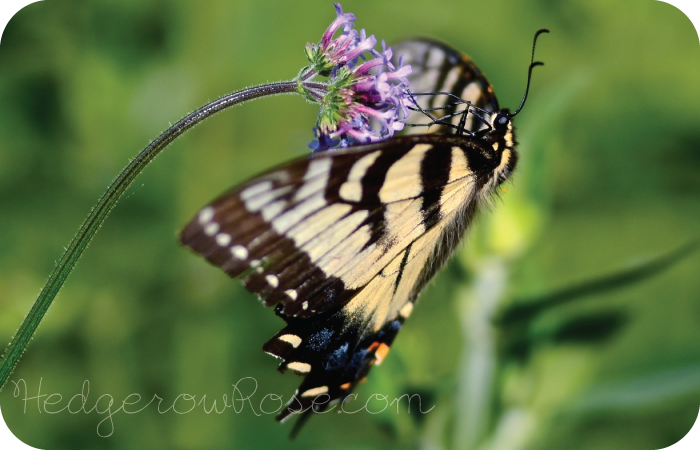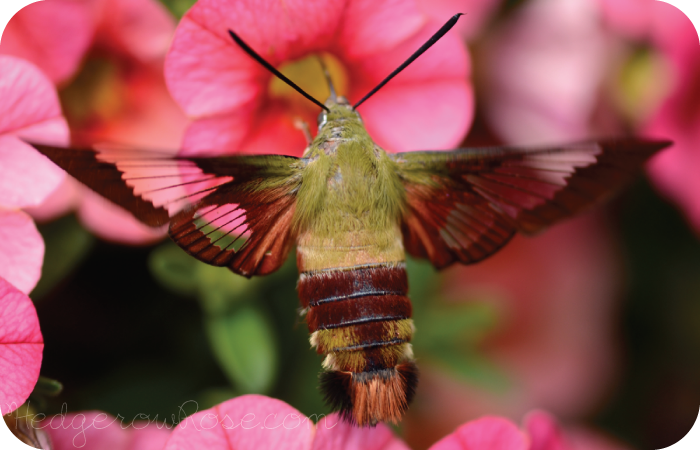5 Tips for Attracting Pollinators to Your Garden
 A yellow swallowtail butterfly visits the flowers of a perennial verbena
A yellow swallowtail butterfly visits the flowers of a perennial verbena
The U.S. Department of Agriculture has designated June 20 – June 26 National Pollinator Week to increase awareness of the decline of our populations of bees, birds, butterflies, bats, moths, beetles and other important pollinators. While in the garden yesterday, a lovely yellow swallowtail butterfly descended to land on the flowers beside me and as I was taking it’s picture, I was thinking about what I could do to attract even more pollinators to our garden. It’s an idea that has been on my mind a lot lately and that led me to the following conclusion: This gardening thing might be getting out of hand. This would make a great topic for discussion, especially since it is National Pollinator Week. (post script: Don’t miss the slide show at the end of this post!)

Bees love the flowers of Hypericum ‘St. John’s Wort’
While researching, I was overwhelmed by the amount of information out there. I mean, on the one hand it’s great that there are so many resources, but on the other it’s almost paralyzing from the pure information overload. So what I’ve done is broken the basics down into 5 easy steps for attracting pollinators to your garden, and while I am not an expert and do not claim to be (she says in italics to further emphasize the point), I think these are pretty good rules of thumb to begin, or add to, a pollinator garden.
1. Provide a Year-Round Fresh Water Source
I feel like this has become my battle-cry; it always seems to come back to this, but yes, this is extremely important, I even think more important than putting up a bird feeder. We use a simple concrete bird bath from spring to fall, replacing with a heated bird bath for winter when temps drop below freezing and a fresh water source is vital. Our bird bath is the hub of the garden and a constant source of activity. Pollinators such as birds and beneficial insects will visit the water source during the day, and I’ve read (although I’ve never seen,) bats will stop for a drink in the evening. If you have a pond, then consider yourself lucky because you’re probably already attracting pollinators, and if you live in an area which freezes over in winter, consider using a de-icer.
2. Go Native
Native plants provide important food sources for pollinators as well as cover, and are often host plants for various forms of butterflies. And here’s the best part: being already adapted to your environment they will be extremely easy to grow. I’m pleased to see that even the big box stores are getting on board by providing native plants in their garden centers, but your best bet is to visit a knowledgable, local grower who will most likely have a wider selection of native plants to attract pollinators for your area.
3. Avoid Pesticides
This is a no-brainer, but it needs to be said. Listen, I grow a lot of roses, which attract a lot of pests, and since we started vegetable gardening I’m seeing insects I didn’t even know existed. If you use pesticides willy-nilly you’re going to kill the good guys as well as the bad guys. The best method of control is to allow the “good guys” to catch up and establish a balance in your garden. I take time out every day for search and squish missions. I’ve become less squeamish about having bug guts on my fingers over the years.
4. Provide Materials for Overwintering and Nesting
While good cultural practices are important to prevent disease and pests, a garden doesn’t need to be pristine. In fact, leaving behind garden debris such as leaves, brush, and twigs is actually a good thing. If you have a dead tree in your yard, and it isn’t a safety concern, leave it be. Don’t be as fanatic about dead-heading flowers, especially seed-producing ones. Provide mud-puddles, nest boxes, mason bee houses, bat houses (although our bats poo-pooed those and prefer the trees instead), and overturned, partly buried flower pots.
5. Diversify and Plant in Groups
Pollinators are attracted to a wide variety of nectar and pollen producing plants, as well as the colors and shapes of their flowers and when their blossoms open. Plant a wide variety to cover all your bases and don’t forget to include night-blooming flowers which will attract moths as well as bats. (I’m a fan of white flowering tobacco, nicotiana, but I remember when we lived in San Diego, my mother grew a night-blooming jasmine, Cestrum nocturnum, which I wish would survive the climate here in PA.) Site this wide variety of pollen and nectar producing plants together in groups or swaths, much as you would see in nature. Pollinators will have a better chance of finding, and staying in your garden if you do so.

A hummingbird moth visits a Calibrachoa




A great post with some great advice. Are you seeing many hummingbirds this year? We had 5 that I knew of last year that regularly visited our feeders. This year, none.
Hi Chris, thanks for the kind words! We have seen hummingbirds already, but here in PA we only have one kind, the ruby-throated, which loves my zinnias. For the life of me I can’t get them to drink from feeders so I just plant lots of flowers for them instead. The numbers do seem to be dwindling, though…
The numbers do seem to be dwindling, though…
I have just written down a list for plants to get, I already have dill and butterfly weed that we got at our local greenhouse/nursery but the slugs are eating everything and so I had to dig up the butterfly weed because it is looking so bad and I put it in a pot and its in the greenhouse until it gets bigger…
Darn those slugs! Have you tried beer traps? They work!